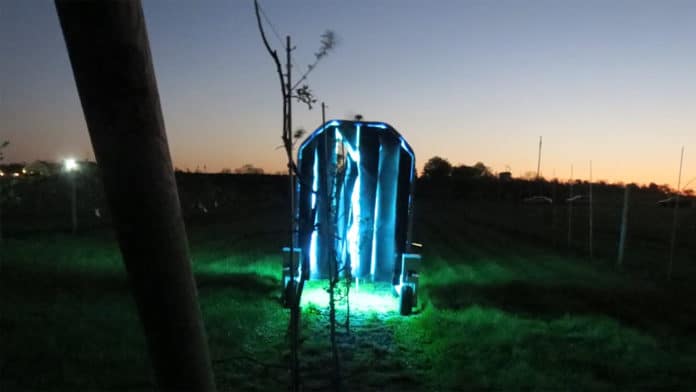Powdery mildew is a common fungal disease that affects a wide range of plants. Standard fungicides are an effective way to manage powdery mildew disease. However, it is expensive, time-consuming, and environmentally unfriendly to routinely treat with fungicide.
Now scientists have found that robots fitted with ultraviolet light may be a better way to do so. Researchers at Cornell AgriTech in Geneva, have partnered with SAGA Robotics in Norway to develop the first commercial robotic unit fitted with ultraviolet light lamps. These autonomous robots roam along rows of grapes in vineyards at night to effectively treat powdery mildew. The UV light robot, named Thorvald, proves effective at killing powdery mildew, a devastating pathogen for many crops, including grapes.
During its movement through the vineyards, the robot irradiates the grape leaves with ultraviolet light. DNA gets damaged when exposed to UV light, though various organisms have developed biochemical defenses against such damage, which is activated by blue light found in sunlight.
“What makes it possible for us to use UV to control these plant pathogens is we apply it at night,” said David Gadoury, a senior research associate in the Department of Plant Pathology, who leads the project. “At night, the pathogens don’t receive blue light, and the repair mechanism isn’t working.”
Delivering a low dose of UV light kills the pathogen without harming the plant. Besides, technology has also proven effective against downy mildew and some insect pests.
Researchers are currently testing two such Thorvald robots on Chardonnay grapes at two sites – Cornell AgriTech’s research vineyards in Geneva, and at Anthony Road Wine Co. in Penn Yan, New York. The robots are autonomous vehicles fitted with 8-by-4-foot arrays of UV lamps. These machines will work seven nights a week, all night long. The robots are expected to go into commercial production later this year.
Additionally, Cadle-Davidson, a partner on the project, is also developing imaging technology in partnership with scientists at Carnegie Mellon University that will detect and quantify mildew on grape leaves. “We’re right now on version 1.0 of this UV robot treatment, which applies the same dose of UV light to every vine regardless of whether it’s sick or healthy,” Cadle-Davidson said. “Our long-term vision is we’ll couple these detection and treatment approaches across the vineyard in an automated way.”
